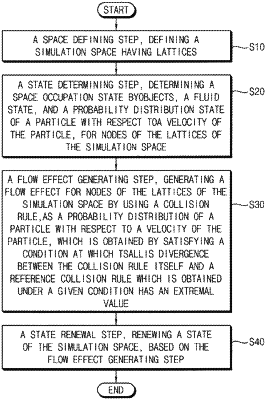| CPC G06N 7/01 (2023.01) [G06F 17/18 (2013.01); G06F 30/20 (2020.01); G06F 30/25 (2020.01); G06F 30/28 (2020.01); G06F 2111/10 (2020.01)] | 16 Claims |

|
1. A method for optimally simulating real fluid flow around a real object using Tsallis divergence, comprising:
(i) by considering the real object, defining a simulation space having a plurality of lattices characterized by respective nodes, wherein, when an initial simulation space is partitioned by a plurality of partitioned spaces according to sizes of the plurality of lattices, neighboring nodes have distances therebetween which are homogeneous in each partitioned space, wherein at least one lattice of the plurality of lattices has a smaller size, and the nodes of the at least one lattice are more densely distributed than sparsely distributed nodes of other lattices of the plurality of lattices;
(ii) transferring the shape of the real object to the simulation space by setting a space occupation state onto the respective nodes of the plurality of lattices of the simulation space;
(iii) modeling a fluid state by characteristics of a real fluid including density, pressure, temperature, and flow velocity of the fluid for the respective nodes of the plurality of lattices of the simulation space;
(iv) setting states including a probability distribution state of a particle with respect to velocity of the particle for the respective nodes of the plurality of lattices of the simulation space;
(v) simulating real fluid flow by generating a flow effect for the respective nodes of the plurality of lattices of the simulation space by using a collision rule, which is based on a probability distribution of the particle with respect to the velocity of the particle; the collision rule being obtained by satisfying a condition at which the Tsallis divergence between the collision rule itself and a reference collision rule has an extremal value under a given constraint to generate a simulated fluid flow result;
(vi) renewing the states based on the simulated fluid flow result; and
(vii) modeling, based on steps (i)-(vi), fluid flow around the real object.
|